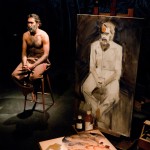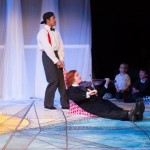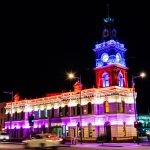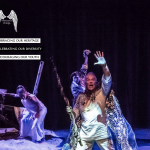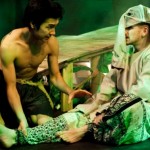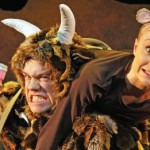Seemingly Invisible
Genre: Puppetry
Venue: Blue Elephant Theatre 59a Bethwin Rd (entrance in Thompson’s Ave) Camberwell London SE5 0XT
Low Down
Seemingly Invisible delicately weaves a set of stage images around six characters who through chance encounters find different kinds of relationships, not necessarily with each other. A busy street: a young man sees a women fall and die; an old man cries and another woman comforts him; a goat is heard bleating; and a ‘small white man’ moves through the same spaces, observing and reacting to the characters and happenings. Like the manipulated thoughts of the play itself, the last character is a simple unadorned white puppet. In other scenes, another puppet comes into being: an old woman, grandmother to one of the characters who retains her words ‘to love’ as the underpinning wisdom of his life.
Review
The relationship between theatre and story making is anything but simple. Sure enough there is the whole of the film and television industry that seemingly obeys Aristotle’s three unities of time, space and action but even then, thanks for Jean-Luc Godard, we know that some filmmakers like to upset the narrative order of beginning, middle and end. By contrast, there have been numerous theatre movements who have rejected Naturalism and Realism, philosophically and in practice. The now famous quote about Waiting For Godot being a play in which nothing happens twice is just one example that shows up theatre making not based on a linear-type narrative. Yet, who would argue that naturalistic story telling continues to be the predominant form? Even among hundred or so experimental London theatres, non-naturalistic narrative forms are on the fringe of the Fringe.
Yet, Seemingly Invisible is one such experiment and while it is not, at this stage at least, on the same level as Beckett’s Godot, the integrity of its aesthetics has something of Beckett’s sense of poetry. Verbal language is sparse and economically used in conjunction with stylised movement, an evocative musical score and an unquestionable transformational impetus to shift the frame in which the audience views reality. This is done by playing with the timing of actions as well as the repositioning of stage properties and objects. With amazing clarity, actions are stretched out across the space: a movement down stage causing a reaction up stage or an encounter between two characters is repeated up to a point and then disrupted with a different gesture, or direction. Lighting designer, Karl Oskar Mac Sordal’s precisely picks up on the mood and timing of the actions.
Who are Smoking Apples? Four young theatre makers with ‘European Theatre Arts’ and Rose Bruford College in common. Harriet Field and Blake Aleksander direct, compose and record the music of the show. Its extraordinary edgy tone operates as an highly unconventional soundtrack: made up of the pulse of an old spinning turntable and the ‘unmixed’ sound of electric keyboard and violin. While definitely ‘unmastered’, the music is far from cacophony. Rather, it is melodic and uplifting. Harriet and Blake also perform in the show along with Matthew Lloyd and Molly Freeman. The four have been working together as Smoking Apples since 2009.
I notice from the programme that Matthew and Molly have studied puppetry in Prague but that all four performers handle the puppets very well. However, it is not appropriate to think of Seemingly Invisible as a ‘puppet show’. It is a play in which some characters are realised through puppetry. What is far more important to view is the interplay between the ‘real’ people and the puppets: how do they extend our understanding of what it means to be human? Humansneed puppets to face their individual and collective potentialities and limitations to animate, to bring into being that part of their own humanity which isseemingly invisible.
For a great deal of the time the interplay works well but it does happen immediately. From where I sat, I felt lost for about the first ten minutes of the play, mainly because most the actions seems to be directed upstage away from me. I was left to watch the backs of actors for what appeared to be no better reason other than the stage furniture had been placed upstage. In fact, as I walked into the auditorium to take my seat I remember thinking how ‘pre-set’ looked merely haphazardly thrown together.
It is only after this uncertain opening, that the show visibly builds its dramatic tension. Each section of the action seems to physically grow out of the preceding action: the setting up of the old man’s table and chairs from the rolling round table; then the screen from the boxed table clothe; leading to the dancing shadow puppets; working besides the dancing couple when the female partner just falls away and so on… By the end, I am totally absorbed at the glimpses of each character’s story unfolding: the young man who sees the death on the street as he is simultaneously experiencing grief at his own grandmother’s death and the old man comforted by a stranger and more. By at the end, after the applause and bows, the whole audience sits in silence. It is only momentarily but long enough to signal that something ‘beyond words’ had been felt towards the characters before us around the human need for companionship and love.
In my case I felt a quiet sort of inspiration and a definite gladness that I had found my way down the unfamiliar streets of Camberwell to reach the Blue Elephant Theatre. I noted the contrast between the unassuming small theatre and the breadth of imagination I had experienced from its stage. I walked back to Camberwell Rd and my bus stop carrying the play’s clear sense of humanity with me.
Reviewed by Josey De Rossi Tuesday 27th September 2011
Website :
http://www.blueelephanttheatre.co.uk/
http://www.smokingapplestheatre.com/
The production is only on until Saturday (1st October). I recommend that you act fast to view it.
